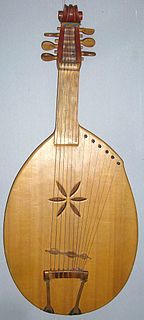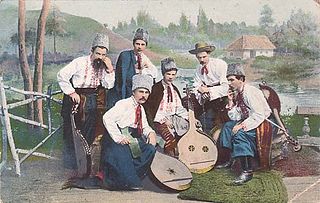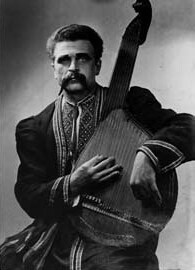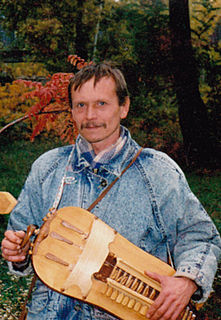Related Research Articles

A bandura is a Ukrainian, plucked string, folk instrument. It combines elements of the zither and lute and, up until the 1940s, was also often referred to by the term kobza. Early instruments had 5 to 12 strings and similar to the lute. In the 20th century, the number of strings increased initially to 31 strings (1926), 56 strings - 68 strings on modern 'concert' instruments (1954).

The kobza, also called bandurka is a Ukrainian folk music instrument of the lute family, a relative of the Central European mandora. The term kobza however, has also been applied to a number of other Eastern European instruments distinct from the Ukrainian kobza.
The Poltava Bandurist Capella was vocal-instrumental ensemble who accompanied themselves on the multi-stringed Ukrainian bandura. It was initially established in February 1925, based on a male church choir who sang in the Ukrainian Autocephalous Orthodox Cathedral in Poltava under the direction of Fedir (Khvedir) Popadych. The ensemble was disbanded in October 1934.
Prystrunky is a term used for the additional strings strung across the body of Ukrainian folk instruments such as the kobza, bandura, and torban. Prystrunky means "near the strings". These additional strings are thought to have appeared on these instruments as early as the 17th century. Others feel that these additional strings appeared later in the mid to late 18th century. On the contemporary bandura they are now the main strings on which the performer plays.
Kobzarskyi Tsekh, literally "Kobzar guild", is an organization of kobzars, which existed from the 17th century in Ukraine.

The Kyiv Bandurist Capella is a male vocal-instrumental ensemble that accompanies its singing with the playing of the multi-stringed Ukrainian folk instrument known as the bandura.
Leonid Haydamaka has left his impression on the development of bandura art in the 20th century.
Kobzarstvo in the wider definition, is the art and related culture of singing to the accompaniment of the Ukrainian folk instruments known as the bandura, kobza and the Ukrainian hurdy-gurdy whom as the lira.
Terentiy (Tereshko) Makarovych Parkhomenko (1872–1910) was one of the most respected kobzars of the late 19th and early 20th century.

The Kharkiv Academic Style of Bandura Playing is a specific method of playing the Ukrainian folk instrument bandura.
Vasyl' Kostovych Yemetz was born in the village of Sharivka, 40 km from Kharkiv, Ukraine. Son of Kost' and Yevdokia (Kurakhovych). Married to Maria Hotra-Doroshenko. Virtuoso bandurist, founder and initial director of the Kobzar Choir in 1918 - the direct protégé of the Kiev Bandurist Capella and the Ukrainian Bandurist Chorus.

Victor Mishalow is an Australian born Canadian bandurist, educator, composer, conductor, and musicologist.
Peter Deriashnyj is a Ukrainian Australian bandurist, composer of secular and sacred music, and choral conductor. He specializes in the Kharkiv style of bandura playing, but also plays folk and rock guitar.
A Kuban bandurists is a person who plays the Ukrainian plucked string instrument known as the bandura, who is from Kuban, a geographic region of southern Russia surrounding the Kuban River.

Antin Paplynsky (Ukrainian: Антоній Паплинський was a Ukrainian musical instrument maker who crafted banduras from 1905-1918. He was rumoured to have been shot by the Bolsheviks in 1919 or 1920. Paplynsky's instruments had 32-34 strings and were diatonically tuned. He was a popular bandura maker because of the quality of his instruments. In 1909 he received a Grand Prix award at the World Trade Exhibition held in Paris. His instruments were sought after not only in Ukraine, but in Russia and Canada.
The Chernihiv musical instruments factory was a factory founded to make stringed instruments in Ukraine. It is named after Soviet politician Pavel Postyshev.
The Honcharenko Brothers—Alexander (1913–2005) and Peter —became the dominant bandura-makers and designers in the Ukrainian diaspora.
Kharkiv-style banduras are banduras that allow for the playing of the Kharkiv style, i.e. using the left hand to play melodic figures primarily over the side of the instrument as opposed to the Kiev style where the left hand primarily plays the basses. To allow for the added required dexterity of the left hand, the instrument is held parallel to the body of the player.

The Hnat Khotkevych Ukrainian Bandurist Ensemble is a vocal and instrumental Ukrainian folkloric performing ensemble in Sydney, Australia. It was founded in June 1964 by bandurist Hryhory Bazhul and since May 1971 was directed by Peter Deriashnyj.

Mykola Petrovych Budnyk Ukrainian: Мико́ла Петро́вич Будник was a luthier and traditional performer in the Kobzar tradition. He was active in authentic construction and recreation of historic folk instruments, and involved in the movement for authentic performаnce practice on Ukrainian folk instruments. Budnyk was also known as a painter and poet. He was born in 1954 in Skolobiv, near Khoroshiv, Zhytomyr region, and died January 16, 2001, in Irpin', Kyiv region.
References
- Diakowsky, M. - A Note on the History of the Bandura. The Annals of the Ukrainian Academy of Arts and Sciences in the U.S. - 4, 3-4 No.1419, N.Y. 1958 - С.21-22
- Diakowsky, M. J. - The Bandura. The Ukrainian Trend, 1958, No.I, - С.18-36
- Diakowsky, M. – Anyone can make a bandura – I did. The Ukrainian Trend, Volume 6
- Haydamaka, L. – Kobza-bandura – National Ukrainian Musical Instrument. "Guitar Review" No.33, Summer 1970 (С.13-18)
- Hornjatkevyč, A. – The book of Kodnia and the three Bandurists. Bandura, #11-12, 1985
- Hornjatkevyč A. J., Nichols T. R. - The Bandura. Canada crafts, April–May, 1979 p. 28-29
- Mishalow, V. - A Brief Description of the Zinkiv Method of Bandura Playing. Bandura, 1982, No.2/6, - С.23-26
- Mishalow, V. - The Kharkiv style #1. Bandura 1982, No.6, - С.15-22 #2 – Bandura 1985, No.13-14, - С.20-23 #3 – Bandura 1988, No.23-24, - С.31-34 #4 – Bandura 1987, No.19-20, - С.31-34 #5 – Bandura 1987, No.21-22, - С.34-35
- Mishalow, V. - A Short History of the Bandura. East European Meetings in Ethnomusicology 1999, Romanian Society for Ethnomusicology, Volume 6, - С.69-86
- Mizynec, V. - Folk Instruments of Ukraine. Bayda Books, Melbourne, Australia, 1987 - 48с.
- Cherkasky, L. - Ukrainski narodni muzychni instrumenty. Tekhnika, Kyiv, Ukraine, 2003 - 262 pages. ISBN 966-575-111-5